Bryanna Clark Grogan’s Vegan Feast Kitchen/ 21st Century Table: The kitchen journal of a vegan food writer.. I'm on Facebook and Twitter (see links in sidebar at right).
Monday, April 27, 2009
A 100% WHOLE WHEAT PIZZA CRUST THAT WE ACTUALLY LIKED!

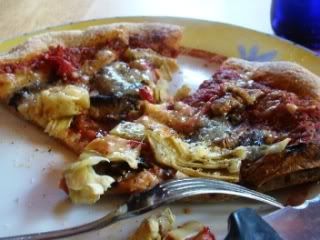
As you may know, if you have read my other blog posts on pizza, I have not really cared for whole wheat pizza crust. I have been using about 1/3 whole wheat flour in my dough, with good results, but the whole wheat doughs I have tried have been awful! Until yesterday.
I have owned a copy of my baking hero Peter Reinhart's book, Peter Reinhart's Whole Grain Breads
However, DH and I are following the Weight Watcher's Core Plan and so we are trying to eat whole grain products for the most part. After a month without pizza, we decided to use our remaining extra points for a pizza blow-out for lunch! I planned it a day ahead and made Peter's whole wheat dough.
The recipe calls for two pre-doughs, a biga (Italian bread starter), which has to be refrigerated overnight, and a soaker, which is some of the flour (in this case-- it can also be whole grains) with liquid and sometimes a little salt.
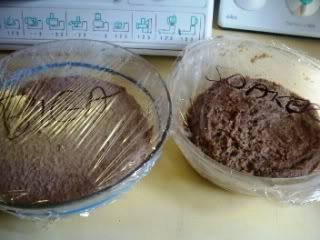
Biga on the left, soaker on the right. I used my home-ground hard red wheat flour, so the dough looked fairly dark. If you used white whole wheat, it would be more golden in color.
You probably have some idea of what a starter is (this one is started with yeast, not sourdough), but why use a soaker? Well, for one thing, flour soaks in liquid for several hours (12-24 hours, in this case), the gluten gets a head start in development. The two proteins that make up gluten begin to join together, which makes the dough more malleable and cohesive. For another, soaking hydrates the bran and germ, which are the harder particles that can cut the gluten strands and sometimes prevent whole grain doughs from rising properly. And, very importantly, soaking flour initiates enzymatic activity. Enzymes convert complex starches into simple sugars, which feed the yeast, which rises the bread. The soaker gives a head start to this process. The enzymic action develops the umami flavor compounds in wheat flour to “ripen” the dough and develop its flavor.
When you are ready to make the final dough, you turn out the soaker on a floured board and cut it into 12 pieces:

Then you get out the refrigerated biga, which has fermented for at least 8 hours,
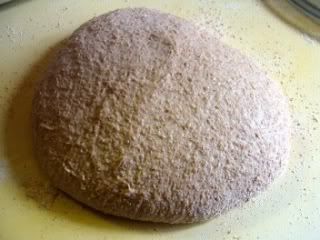
and cut it into 12 pieces, too.
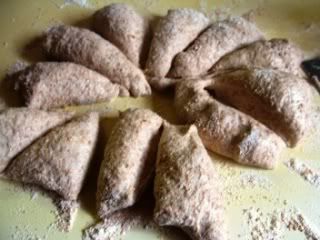
(NOTE: Peter Reinhart says: "... The surface of the soakers and bigas will sometimes darken due to oxidation--no harm but if you want to avoid it, lay some plastic wrap directly on the surface of the dough to keep it from reacting to the air...")
Then you place them in your stand mixer with the other ingredients for the final dough (yeast [he uses instant yeast added with the flour-- I didn't have any, so I used ordinary dry active baking yeast dissolved in 1 tablespoon warm water-- you have to use about 1/3 more regular yeast than instant], salt, a little more whole wheat flour, olive oil, sweetener of your choice).
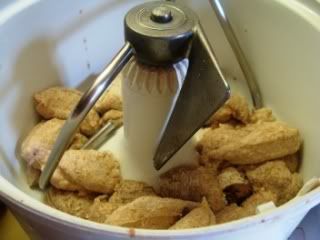
Then, knead it. The dough, once risen, can be refrigerated for up to 24 hours before use, and it can be frozen, too.

The dough was moist and easy to handle. (See an alternative way to stretch the dough at this post.) Although the instructions said to divide the dough into 5 parts, I divided it into 4, so that we could each have a good-sized individual pizza, and then freeze enough for 2 more.
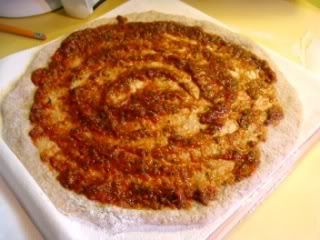
I added the topping just before I baked each pizza.
IMPORTANT NOTE (this applies to any pizza dough): If you have a pretty moist dough (such as a no-knead dough) and you are making a thin crust pizza, letting it sit too long with the toppings on it may make the dough soggy and very difficult to get it off the peel! (As you can see in the photo, it is already on my custom-made 12"-wide Mini SuperPeel. You can get the 14"-wide SuperPeel here
BTW, here's a post I did about using a cast iron skillet instead of a pizza stone-- love it!
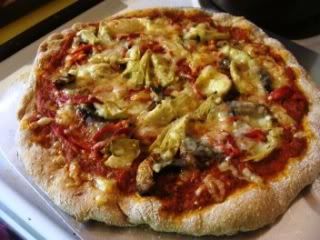
The verdict?
We liked it! It puffed up nicely on the edges and it had a nice flavor-- not "muddy", which is the only way I can describe some whole wheat crusts. I found the rim of the first pizza crust I baked a bit dry, so I sprayed the rim of the second pizza crust with a little oil from my pump-sprayer
Reservations? It was still a bit coarse for my taste, though, but that might have been our home-ground flour. I want to try it with white whole wheat flour and see if that makes a difference. I would probably also add a bit more salt.
One whole pizza crust (1/4 of the dough) was 9.7 points. It was worth it (we had saved up points)! I didn't want a measly 2 little slices-- I wanted it to be my whole meal! I figured that if I try the recipe again with a white biga dough, and the rest whole wheat (maybe white whole wheat), it might come up to my expectations better. If I use 1 1/2 tablespoons olive oil in the dough, instead of 2 tablespoons, then the points will be pretty much the same as the a 100% crust (actually, slightly less-- 9.2).
So, stay tuned for updates!
BTW, I can't reproduce the recipe here, since it's not online anywhere, so I don't think he wants it posted all over the 'Net. The book is worth buying (both of them, actually), anyway, if you are a serious baker, and a good price on amazon even for the hardcover version.
Enjoy!

Subscribe to:
Post Comments (Atom)
4 comments:
I have that cookbook too and so far I've liked everything I've made. I'll definitely have to give the pizza crust a try!
Yours looks yummy!
Oh darn, what a tease! I guess I will have to get that book.
love ur blog and the food .. the cats are seriously cute.
Interesting.
Mark
Post a Comment